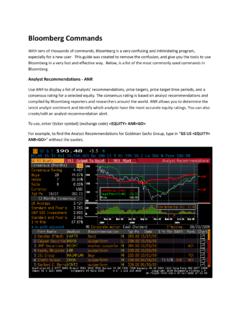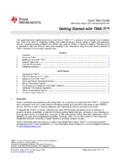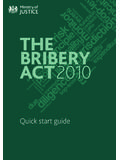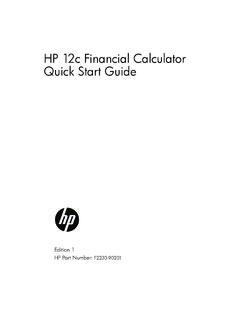Transcription of Excel Add-ins Quick Start Guide - Rotman Finance Lab
1 Excel Add-ins Quick Start Guide Contents Bloomberg - Excel Add-In .. 2 Datastream - Excel Add-in .. 9 FactSet - Excel Add-in .. 13 Thomson Reuters Eikon - Excel Add-in .. 19 Page | 2 Bloomberg - Excel Add-In Bloomberg has an Excel add-in tool which allows users to download current information, historical information and bulk data to their Excel spreadsheets. 1) To launch the Wizard, select Bloomberg and then click Real-Time/ Historical . Then select the type of data needed based on your objective. Note that for Historical End of Day , the starting and ending dates are both compulsory. 2) For example, if you want to find out the price of all stocks in the Dow Jones Industrial Average, select Market, Reference, Analytical, Data Sets and then find the DJIA index and click <ADD ALL> <NEXT>.
2 Page | 3 3) Then type in Price to search for relevant fields. In this case, double click PX_LAST to add that to your field. 4) After selecting the desired format and layout, the data should be exported into Excel . Page | 4 Obtaining Real-Time Quotes 1) To obtain a real time quote for one or more securities, select Market, Reference, Analytical, Data Sets . 2) In the screen that follows, type the desired ticker into the Security Identifier field and double-click on the specific security from the auto-complete dropdown menu. This security should now appear in the Selected securities box on the right. The Bloomberg ticker convention for equities is as follows: <ticker> <space> <country code> <space> <security type>. The ticker symbol for Microsoft would be MSFT US Equity.
3 Once the desired security has been selected, click Next. 3) Leave the Field Source as Bloomberg Fields and select the relevant data fields by expanding the categories below. You can also search for data fields by entering keywords into the Search text field and clicking the Search button. For example, you can search for the Bid Price, Ask Price, and Last Price fields. Other commonly used keywords include Volume, Change, High, Low, EPS, P/E, Beta, and Dividend Yield. The selected fields should appear in the box on the right. Click Next once the desired fields have been selected. Page | 5 4) The last step is optional and allows you to specify the layout of the data output on your Excel worksheet.
4 Click Finish when you are satisfied with the specified layout. Ensure that the Real-Time Updates box is checked. Page | 6 5) In order to obtain real-time quotes for all of the securities in an index, follow Steps 1 above. In the following screen, leave the Security identifier field blank and choose Indices in the From: drop-down menu under the Select securities section. Select the desired index from the Indices: drop-down menu, then click Add all. You may also choose to select only specific securities from the index and then click Add. The relevant securities should appear in the Selected securities box on the right. Click Next and follow Steps 3 and 4 above to finish. Page | 7 Obtaining Historical Quotes 1) To obtain historical quotes for one or more securities, select Historical End of Day.
5 2) From the Real-Time Quotes section above, follow Steps 2 and 3 for individual securities, or Step 5 for securities in an index. When selecting fields, similar data such as Last Price can be obtained. It is unnecessary to select the Date field, as dates will be automatically populated in Excel when obtaining historical quotes through the Bloomberg add-in. 3) For historical data, you must select your preferred Periodicity and Time Frame. Fixed Time Series produces historical data for a fixed time frame. Please note Fixed time series, both a Start date (the From: field) and an end date (the To: field) must be entered. Relative Time Series produces historical data for a fixed number of periods, which will constantly be updated as current day changes.
6 If we select Relative Time Series with the End date as Today and Number of Periods as 30 days, the data output will update accordingly and pull out the historical data for the past 30 days from today s date. Once you have selected your Periodicity and Time Frame, click Next. Page | 8 4) You may wish to select a different currency in which to report the historical quotes, or retain the default for the specific security. Click Finish once you are satisfied with the parameters selected. Page | 9 Datastream - Excel Add-in What does the Datastream Excel Add-in do? The Excel Add-in allows you to access the Datastream database directly from within Microsoft Excel . Using Excel , you can create and embed data requests that put the data you want straight into your Excel spreadsheet.
7 Datastream gives you access to the world s largest and most respected historical financial numerical database. Datastream provides a range of charting and reporting tools that enable you to manipulate and display, or simply download that data in the way that you want. Where is the Datastream Add-in? The add-in for Datastream can be found at the top right tab under Datastream . Downloading data from Datastream to Excel In order to download data you have to make a request . There are two types of requests: 1. Time series request: requesting data of one or more series over a certain time period. 2. Static request: requesting data of one or more series on a specific date. Each of these request types consists out of 4 steps: Page | 10 1. Enter the series for which data is needed.
8 2. Enter the type (datatype) of data needed. 3. Specify the date or time period over which the data is needed 4. Set options First step: choose the series While still under the Datastream Tab, choose the type of request that you are interested in. In this case, we will choose Time series request. Second step: choose the datatype In the Time series request window, once you have identified the security for which data is required, it is important to specify which kind of information is needed by filling in the datatypes box. If this is left blank, a default setting will be assumed. To choose the datatype click fx on the left side of the datatypes field. This will take you to a window that provides you with the various datatypes available along with their respective definitions.
9 The datatypes in this window can be sorted by function and description. Next page: see picture of time series window along with datatypes (Function help) window. Page | 11 Third step: specify the data period Within the time series request window, to choose the data period there are 3 boxes of input available: 1. Start date: you can enter the Start date in in two ways, (1) relative or (2) absolute. a. Relative: the default setting -2Y will result in data being downloaded from the past 2 years to the end date. Here Y means years. But you can also use D for days, W for weeks, M for months, and Q for quarters. b. Absolute: this is used to retrieve data for a fixed time period. Enter the Start date and end date in the following format: dd/mm/yyyy.
10 You can also enter Base Date , this will Start the data series from the date that data is first available. 2. Frequency: choose from the drop down menu the time intervals for your data series. 3. End date: Choose your end date. If left blank, the default setting will be to choose the most recent date. Fourth step: choose options You can set options about how the output will be downloaded to Excel . It is useful to check Display Row Titles , Display Column Titles , Display Headings and Display Currency to have a clear overview about which data was downloaded. It is also useful to check the Embed and Visible Button boxes. This will embed the request into the Excel sheet so that the user can easily update or edit the request. If the Auto Refresh box is checked your work will be automatically updated the next time you open Excel , provided that you are using a computer with Datastream.








